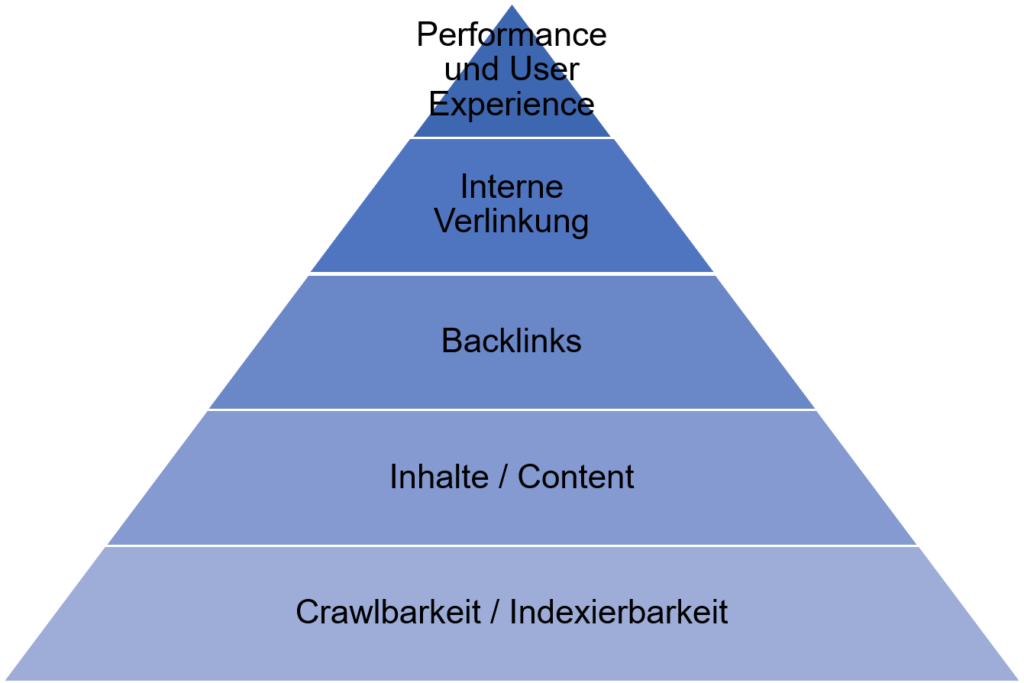Which SEO Measures Are Really Important?
Among the many possible SEO measures, it is important to use those that really bring something, and with reasonable effort.
The essentials in brief:
- SEO measures should be prioritized depending on their contribution to the rankings, the added value for the site visitors and the effort involved.
- SEO measures can be divided into different levels that build on each other. Most important are the measures at the lowest level.
- This results in an SEO needs pyramid.
SEO or search engine optimization is a very broad field. If you haven’t dealt with the topic for that long, you are often faced with a huge mountain of possibilities and starting points without knowing where to start.
In order to be able to take the right SEO measures, you have to know which approaches lead to success, how much effort is involved and how long it takes for SEO measures to take effect.
Note: This article does not describe SEO measures in detail. This is reserved for the relevant specialist articles. It’s just a matter of comparing the tools available from the SEO toolbox and showing which priority they should have.
In order to be able to assess the importance of SEO measures, three criteria must be observed in particular:
- How does an action affect the Google ranking factors, and how important are these ranking factors?
- How does the measure affect user satisfaction?
- How much effort is involved in the measure?
Recently, it has been observed that points 1 and 2 are growing together because Google is becoming better and better at recognizing the interests of users. This is due in particular to the improved analysis options for texts that Google can use as its technology advances.
Categories of SEO measures
Basically, all SEO measures can be classified into one of the following categories:
- Measures to enable a website to be crawled and indexed
- Content optimization measures
- Build relevant and high-quality backlinks
- Internal link optimization
- Optimization of performance and user experience
But how are these categories related to each other? This is best explained using a widely cited and quite simple model: Maslow’s hierarchy of needs. This describes human needs in a hierarchy. The needs of the previous level must always be met before the needs of the next higher level come to light. The different levels of Maslow’s hierarchy of needs are:
- Physiological needs: They include, for example, eating, drinking and sleeping.
- Security needs: Protection from attacks and maintaining physical integrity, but also financial security
- Social Needs: Family, friends, wider social relationships
- Individual needs: for example, desire for professional success and reputation
- Self-realization: creativity, development of personality
Despite all the criticism, Maslow’s model has survived to this day and can at least serve as a simplifying basis for explaining many phenomena.
This hierarchical structure can also be applied to the importance of SEO measures. Following Maslow, the SEO needs pyramid would look like this:

Crawlability and indexability
At the lowest level are the crawlability and indexability of a website. Only if these are given can the website appear in the search results of Google and other search engines. If there are problems here, such as an incorrectly configured robots.txt that blocks crawling, appropriate countermeasures must be taken. Other examples of problems that can prevent crawling and/or indexing are incorrect meta robots tags (“noindex”) for pages that are supposed to be indexed, or sending server errors when trying to fetch individual pages of a website. Only when a website is crawlable and indexable does it make sense to look at the next higher levels of the SEO needs pyramid.
Content
The next level is the content of a website. They are the most important ranking factor for Google. Good rankings for competitive keywords can only be achieved if relevant content with added value for users is available on a website. Google has recently increased its requirements for website content. This is ensured not least by the various core updates, the helpful content update and the product reviews updates. They are all designed to ensure that original content based on expertise, specialist knowledge and your own insights appears higher up in the search results. It is always about relevance and added value. Copied and automatically created content, on the other hand, should be devalued.
On large websites in particular, the question arises as to how content should be optimized. The motto here is “quality before quantity”. It’s better to have little quality content than lots of low quality content. Therefore, the pages and content of a website should be prioritized: the most important content is optimized first, all other content follows later. When creating new content, quality should prevail over quantity.
Backlinks
Backlinks are still of great importance when it comes to rankings in Google. For Google, backlinks are a signal of a website’s popularity and authority. However, it would be wrong to rely solely on link building because of the assumed importance of backlinks. Backlinks are only useful if they are used in combination with the underlying measures of the SEO needs pyramid. A website that cannot be crawled or indexed will not achieve any serious rankings, even with the best backlinks. This also applies if there is a lack of relevant content.
Internal linking
Internal linking is still a ranking factor that is often underestimated. Google uses internal links to evaluate the importance and thematic relevance of the pages of a website. By setting internal links in a targeted manner, a page can receive a significant boost in the rankings. It is important to ensure that the links come from relevant sites. The anchor texts should also be chosen appropriately. The placement of the links also plays a role. Editorial links from the continuous text are particularly valuable.
There are different ways to check the internal linking of the pages of a website. One of them are tools like Screaming Frog, which can provide at least a rough overview of the internal popularity of individual pages via link analysis. If you want to know more about it, you can calculate the internal PageRank of the pages. The calculation works like the PageRank on the web, which Google also uses, except that the calculation is limited to the pages of the website.
Performance and user experience
Much is written about performance criteria such as the loading time of websites. The user experience also includes things like mobile friendliness, secure transmission via HTTPS and the absence of annoying pop-ups or so-called interstitials. Google has grouped these things under the term Page Experience, which is a ranking factor. An essential part of the page experience are the core web vitals, which, in addition to the loading time, also include the reaction speed of pages and the visual stability of the page when loading.
There is a wide range of optimization options, especially to improve performance. Some of these are easy to implement, while others are very complex. Here many make the mistake of putting too much work into small additional improvements that ultimately bring little. It should be emphasized in particular that the performance of a website has only a comparatively small weight among the ranking factors. Google refers to ranking factors with little importance as tie-breakers: These are ranking factors that make the difference when there is a stalemate with other ranking factors. The core web vitals, which depict the performance of websites, are more important than tie breakers, but have far less influence than, for example, the relevance of the content.
Conclusion
The prioritization of SEO measures should be based on their efficiency. What is important are measures that have a major impact and require comparatively little effort. It must first be ensured that the search engines can crawl and index the content at all. The content itself is on the next level, followed by backlinks and internal linking. Performance and user experience are at the highest level. However, that does not mean that they are unimportant. A website must of course be usable in principle in order to function. This is mainly about technical optimizations that raise a website from a sufficient to a very good technical performance and user experience.
If you want to know more about the importance of SEO measures, you should take a look at the Google Search Essentials. This is a very good description of the basic requirements that must be met in order for a website to appear in search and what needs to be done in order to consistently achieve good rankings.



